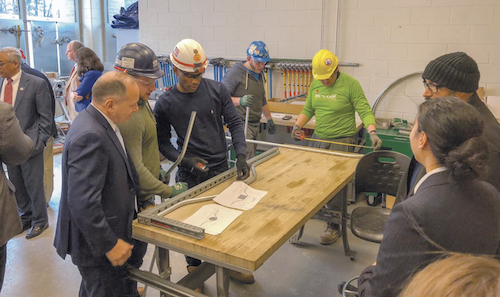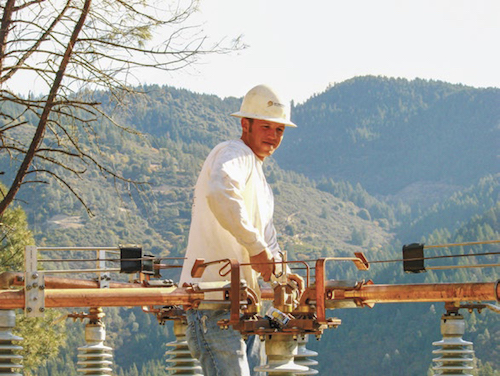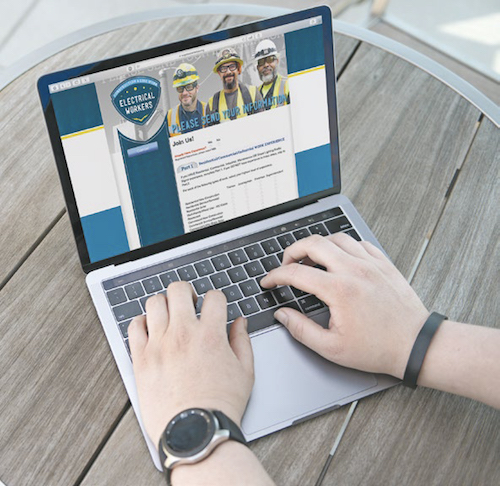The future of organizing is here, IBEW leaders say, and new tools and technology will play a key role in recruiting the next generation to meet the needs of a growing electrical industry.

|
| Organizing new members into apprenticeships is critical to meeting the demands of a growing construction industry.
|
Since Henry Miller first traveled the U.S. organizing members into the National Brotherhood of Electrical Workers in 1891, the mission has been the same: grow the union; increase the strength of workers through solidarity and collective action; and improve their lives.
A lot has changed in 128 years, but the IBEW’s commitment to organizing every worker in the electrical industry is unwavering.
“Organizing is fundamental to who we are as a union and as IBEW members,” said International President Lonnie R. Stephenson. “It’s fundamental to getting the jobs that put food on our tables, too, and that’s why we’re embracing technology and methods that will help us revolutionize the way we organize more workers, more work and more contractors.”
Over the last several months, membership development staff have introduced new online tools to support a strategic organizing approach at all levels and in all branches of the organization. A new recruitment website, an online organizing platform and local union strategic organizing plans are designed to work hand-in-hand with existing infrastructure and to enhance and streamline the successful organizing strategies honed over the labor movement’s history.
“These new investments in time and resources build on the tried and true organizing methods that we know work. They broaden our reach and make us more efficient,” said Ricky Oakland, special assistant to the international president for membership development. “After a lot of work behind the scenes, we’re excited to finally be able to share them with organizers at every level of the IBEW.”
Are You an Electrician Looking for Work?
The North American construction industry is booming. That’s great news for the IBEW’s construction journeymen and apprentices, but it means a hard road ahead for organizers.
Consider the goal shared by President Stephenson and David Long, NECA’s chief executive officer: to grow our inside market share 10 percent by 2025. “When the industry is growing the way it is, we need to be growing faster,” Oakland said. “The alternative is that someone else gets that work, and we’re greedy about winning jobs for our members and contractors.”
In March, the IBEW launched WePowerAmerica.org with a mission to connect electrical workers with quality union jobs and to boost construction locals’ market share.
“With this new website, men and women in our craft — or those who would like to join us — have a terrific way to learn about and apply for the thousands of good union electrical jobs that are expected to open up in the near future,” Stephenson said. “We’re reaching out to traditional apprenticeship applicants, but we want the folks already working nonunion in the industry as well. There’s a path to a better career with better pay and benefits for those people, too.”
Prospective electricians visiting WePowerAmerica.org can connect with the IBEW as well as with employers, dispatchers and signatory contractors under the jurisdiction of more than 300 of the union’s inside and outside locals.
“For the first time, we have a comprehensive, centralized listing of available work for a variety of experience levels across the United States,” said Director of Inside Construction Organizing Virgil Hamilton, who hopes to eventually expand the site’s reach to Canada, too.
The website assesses visitors’ experience levels and then routes them to the right resources. Applicants can choose which locals will receive their application information, and those locals will contact the applicants and determine the next appropriate steps.
A separate, regularly updated “Hot Jobs” page on the site lists jobs that have a pressing need for electrical workers with inside or outside experience. Hamilton hopes that this page will serve as a magnet for both current and potential members, especially those willing to travel for work. Local leaders can contact their state organizing coordinator to have jobs placed on the page.

|
| Together, these new organizing tools will redefine the way we bring new people into the IBEW, brightening the work picture for every member.
|
But organizing remains the website’s primary objective. Its ability to connect nonunion electricians with IBEW organizers has Oakland and Hamilton excited about its potential.
“With corporate-owned temp agencies like Tradesmen International and Associated Builders and Contractors working harder than ever to replace us, this new website will play a crucial part in helping us meet our ambitious market share goals,” Oakland said.
And if an applicant indicates that they have electrical experience with a non-signatory contractor or nonunion employer, Hamilton said, that’s a perfect opportunity for locals to dig deeper and perhaps gain more market share.
“The website is like a fishing pole,” he said. “We might hook a little fish who knows where the big fish are and can tell us more about them.”
Hamilton noted that a promotional push in the first month the site was live netted locals contact information for nearly a thousand experienced applicants. “Early results have been incredible,” he said.
Members should expect to see WePowerAmerica.org showing up soon on T-shirts, business cards and television commercials. “What we’re trying to do with this thing is to get our brand out there and get brand awareness and loyalty through repetition,” Hamilton said.
The Professional/Industrial side of Membership Development has long maintained its own website at IBEWYes.com, aimed at organizing new IBEW members in the government, manufacturing, telecom, broadcast, railroad and utility branches.
“The site underwent a bit of an upgrade over the last several months,” said Director of Professional/Industrial Organizing Jammi Juarez, pointing to a more modern look as well as some under-the-hood updates that improved its functionality.
“Potential members are looking at everything you do when you’re saying the IBEW is the best choice to represent them,” Juarez said. “Putting a professional face on that is really important.”
Revolutionizing the Face-to-Face
As any good organizer would tell you, there’s no replacement for a face-to-face contact. The trust required to take a risk and push for a better life for yourself and your family — for a union career — needs that look in the eye and the reassurance from someone who knows what’s on the other side.
So how do organizers apply technology to a basic human interaction that’s been around since the beginning of time?

|
| The new WePowerAmerica.org website invites potential members to outline their level of electrical experience with a detailed questionnaire.
|
Action Builder, a new tool for construction and professional/industrial organizers, puts the ability to condense hours of labor and mountains of paper into the cell phone already in your pocket, and it makes getting those face-to-face interactions quicker and more effective.
“This is a game-changer,” said Eric Jackson, a state organizing coordinator in the Sixth District. “Doing an organizing blitz now with Action Builder compared with doing it ‘old school’ takes about half the time. It automates nearly the entire front-end planning process.”
The tool’s real advantage is how gathered information can be uploaded easily into the IBEW’s Organizing Accountability Reporting System, Jackson said.
“This cuts down on time in front of a computer doing data entry,” he said, leaving more time for the local organizer to get in the field and do home visits.
“We’re trying to make it easier for organizers to get out of the office and organize,” said Adrian Sauceda, an international representative in the Membership Development Department who has helped lead the development and rollout of Action Builder at the IBEW. “You’re having conversations, not making presentations.”
For Carl McPeak, a lead organizer in the 10th District, the IBEW’s new tech tool has done just that, letting him spend more time on the fun part of the job, interacting with working people.
“Before, I’d get a hotel room with two beds,” he said. “One was just to lay out notes on, with papers stacked all over, and I’d be up until 1 or 2 a.m. getting ready for the next day.”
McPeak used Action Builder recently for the first time on an internal campaign at a Milbank Manufacturing facility in El Dorado, Ark., where he found the tool’s ability to display his organizing team’s notes in real time particularly helpful.
“Now, I can sit down at the laptop after I finish with house-calling,” he said, “and 15 minutes later I’m done with the prep and cutting turf for the next day and can get some sleep like a human being.”
A map function helps organizers more efficiently plan house calls, and the capability to create efficient routing from one call to the next will roll out soon.
Action Builder also allows an organizer who spots a new, unlisted work site to record it for later investigation about the job’s contractors and progress.
In the months before it was officially rolled out in March, Action Builder went through rigorous testing by organizers with Seattle Local 77, who used it on a membership outreach campaign, and by organizers with Richmond, Va., Local 666, who have been using the app for house calls.
“We’re getting people used to the idea that the union is looking for workers,” said Local 666 Business Manager Charles Skelly, who said he’s intrigued by Action Builder’s possibilities, especially as the tool helps him get a better understanding about what is happening in his local’s sprawling jurisdiction.
“Any time we can move past pen and paper, that’s awesome,” Skelly said.
Since Action Builder was launched across the U.S. and Canada in March, more than 9,000 new professional/industrial and construction prospects have been uploaded to it for contact. Lists from jobsites and state licensing boards and eventually prospects from the WePowerAmerica.org and IBEWYes.com sites will exist there, too.
And although the easy-to-use tool does not require training, it’s still available.
“Get in touch with anyone on your membership development team, and we’ll make sure your local organizers know how to make the most of this tool,” Sauceda said. “We’re going to keep improving it every chance we get.”
At the International Office, Sauceda is available to assist members on the construction organizing side, and International Representative Jennifer Gray can help with those working with professional/industrial organizing.
“Action Builder is a particularly great tool for use on an ongoing internal organizing campaign,” Gray said, especially in so-called “right-to-work” states and in light of last year’s ruling by the U.S. Supreme Court in the Janus v. AFSCME case, which eliminated the requirement of organized state and local government workers to pay agency fees.
“You can house assessments and notes, tag workplace issues and concerns, record whether a worker has joined up, all within Action Builder,” she said. “It’s a tool customizable for locals’ needs.”
Make a Plan and Stick to It
It’s not just technology that is changing the face of organizing across the IBEW.
“We can give you all the tools in the world, but if your members or your leaders aren’t bought in to organizing, it’s not going to do you any good,” Oakland said.
And that’s where the final element in the new approach comes in. His department’s Strategic Organizing Program is a crucial piece of the process, designed to help turn every member into an organizer.
“Strategic organizing means asking the right questions to spur members into really thinking about what works and what doesn’t,” Hamilton said. “If the members don’t have a say, they don’t have any ownership or passion.”
The new program emphasizes the necessity to organize the workers, the work and the employers simultaneously. “Putting all your energy into just one of those doesn’t work,” Hamilton said. “And you have to come up with strategies that cover the good times as well as the slow times.
“Our goal is to start a culture of change where all of the local’s members are accountable. We want them to give some thought about how they get from where they’re at to where they want to be.”
To get buy-in from members, the program, which locals can request through their district office, begins with a full day of gathering information. The next day, Hamilton meets with the district and state organizing coordinators to turn what was learned into an organizing plan. That goes to the local’s business manager and executive board for review and approval. “They’re in control the whole way,” Hamilton said.
“When we’re done, the goal is that a local has a roadmap for growth, an engaged membership and that we’ve planted the seeds to grow a culture of organizing,” Oakland said. “When you put that together with these new tools, we think we’ve constructed a solid foundation for success.”
But growing the IBEW and gaining market share and creating more jobs has to be a shared goal, from the top of the Brotherhood right down to the first-year apprentice, Stephenson said.
“Growing this union is the responsibility of each and every one of us,” he said. “These new tools will help us do that, but it’s the commitment from the sisters and brothers of the IBEW that will help us recruit those new members and win those jobs that can only be done by the best-trained, most professional electrical workers in North America.”